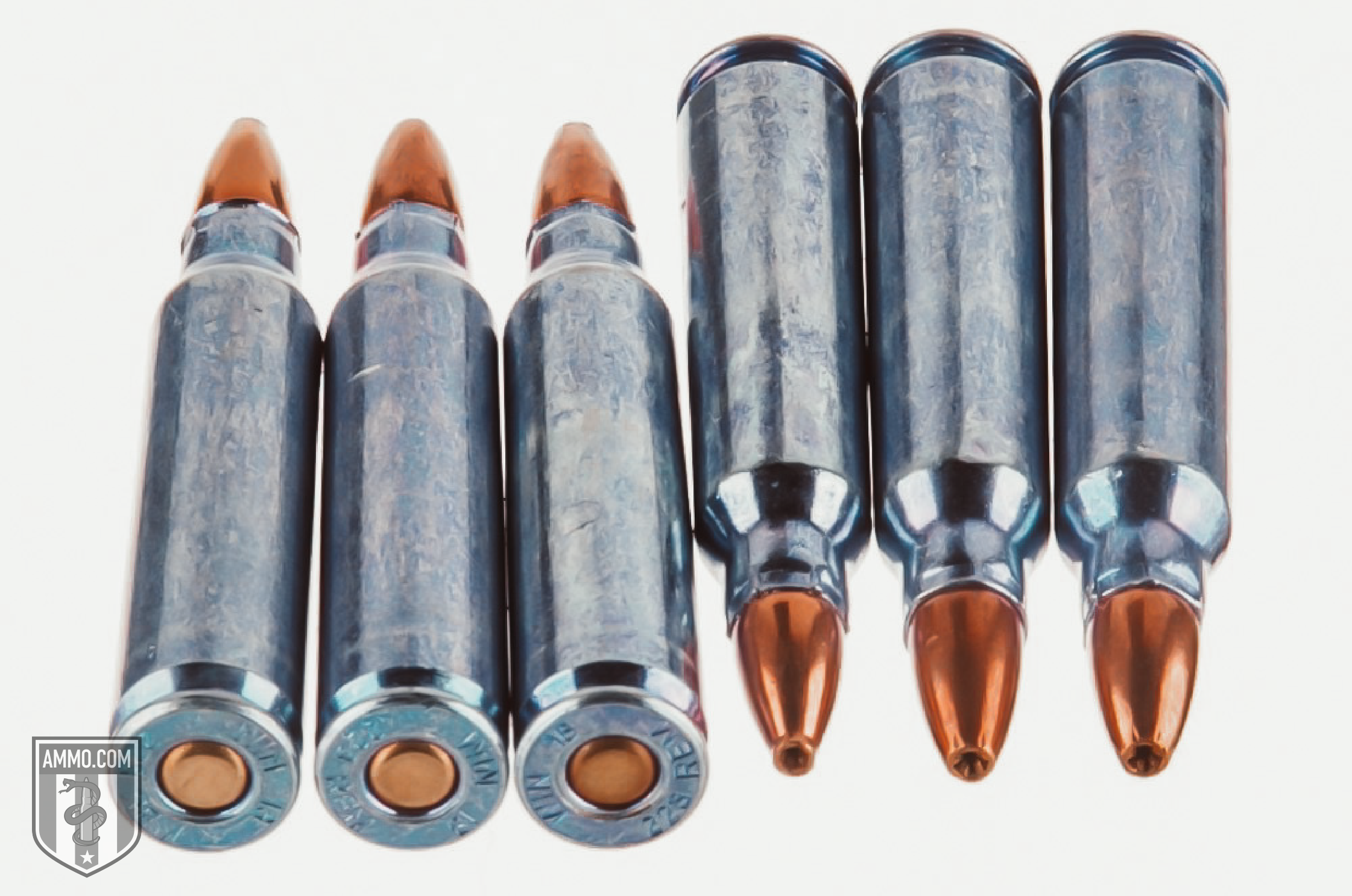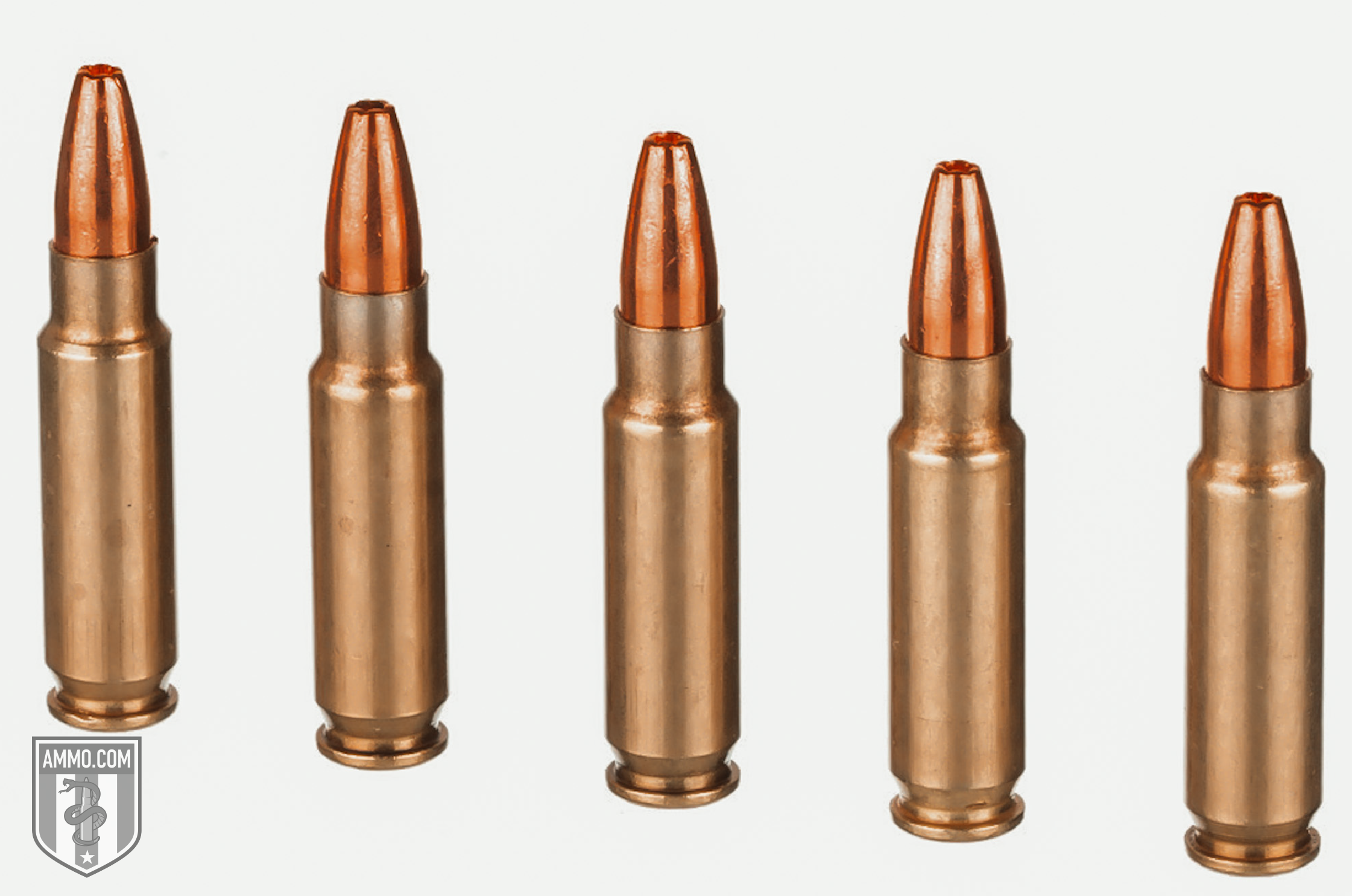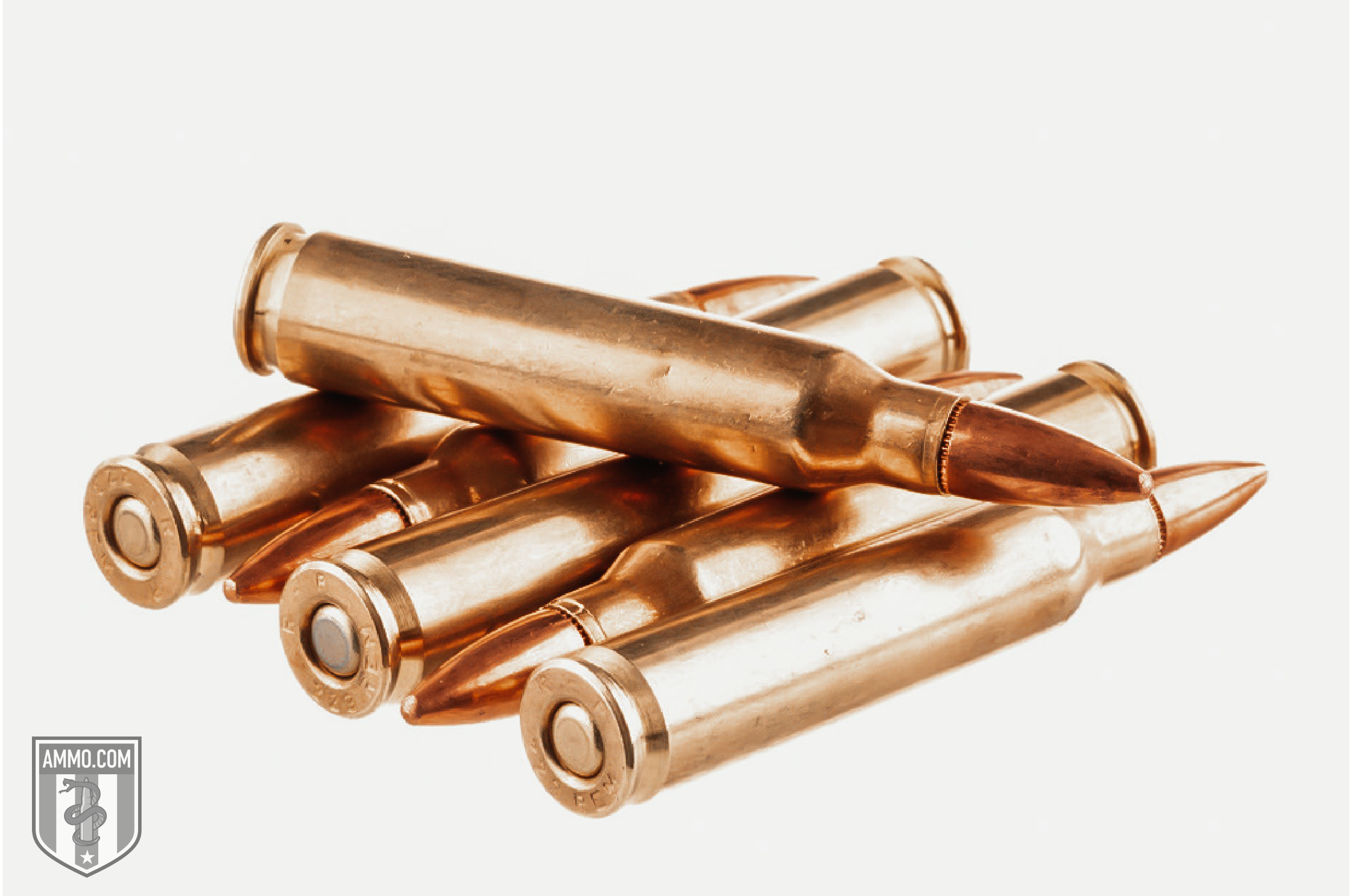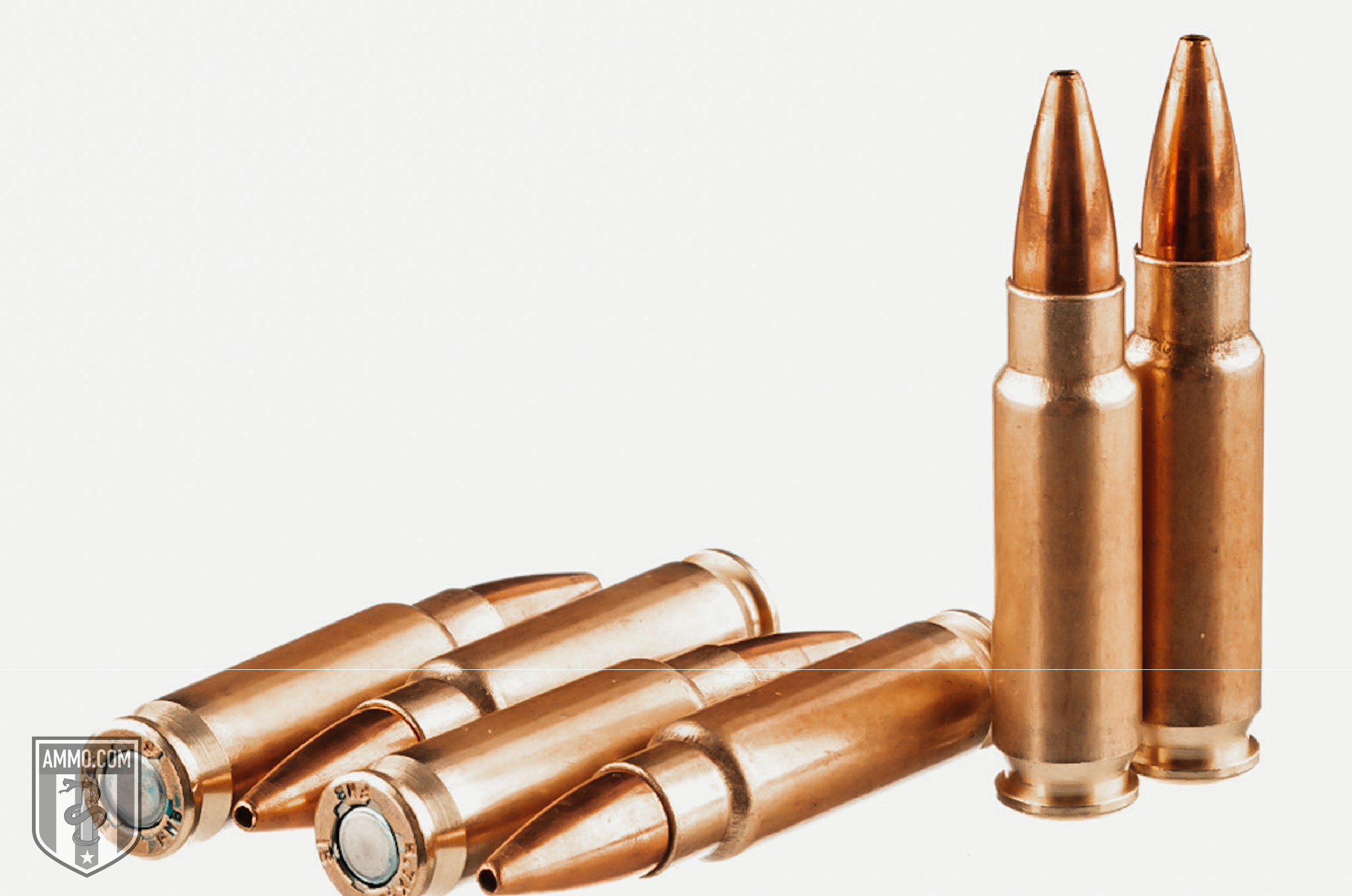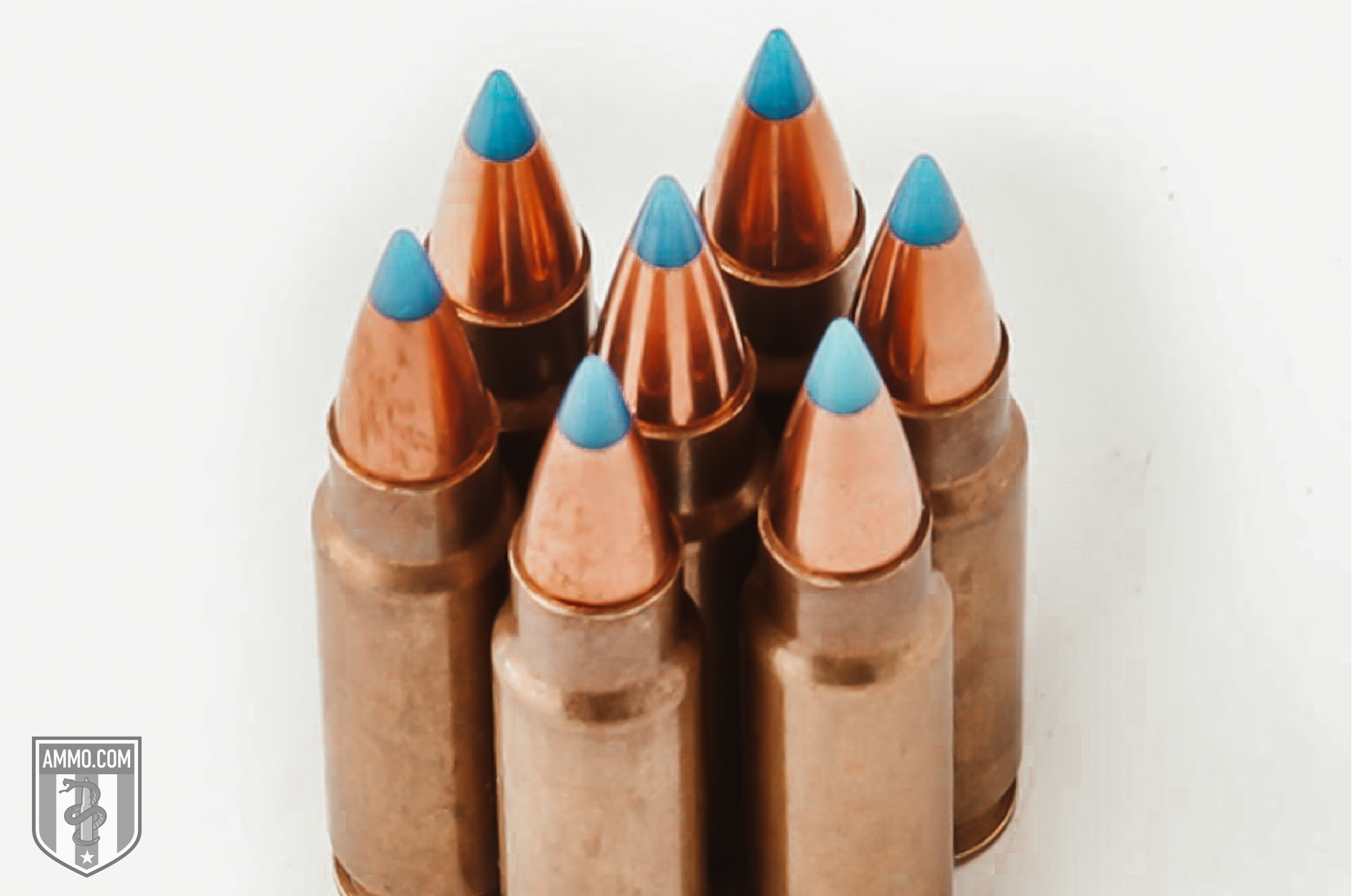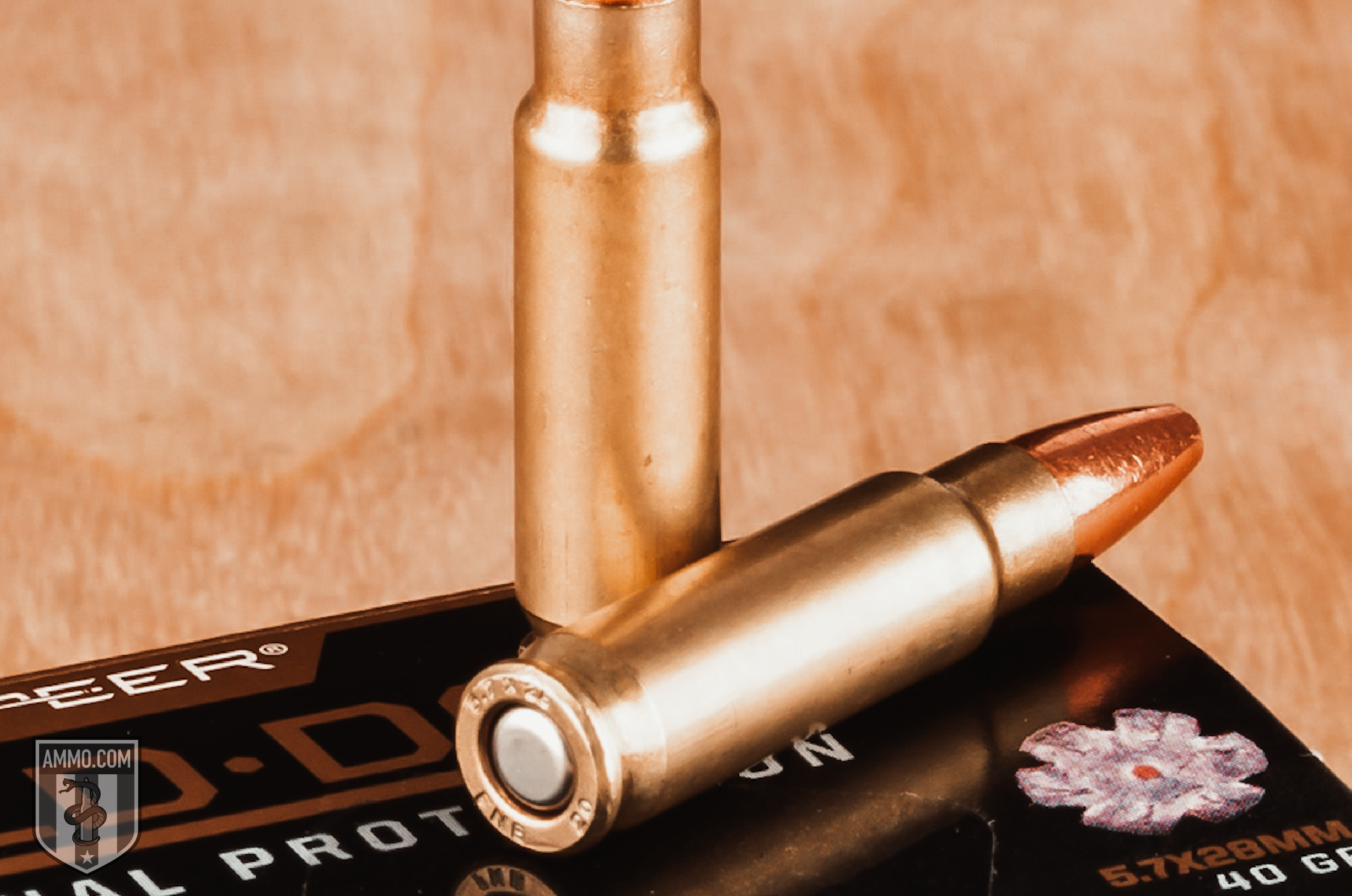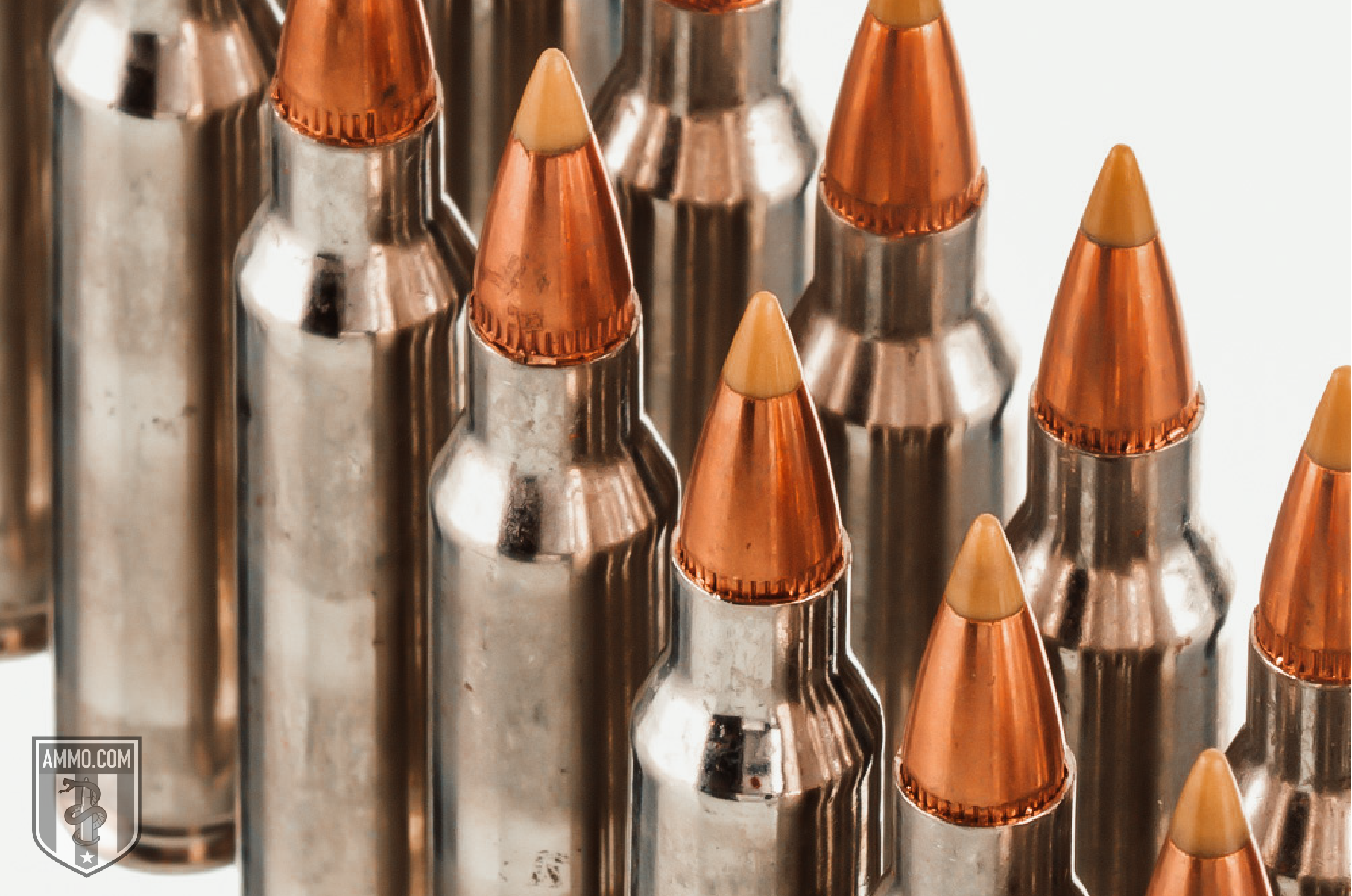5.7x28 vs 223: Which Is Better For CQB?
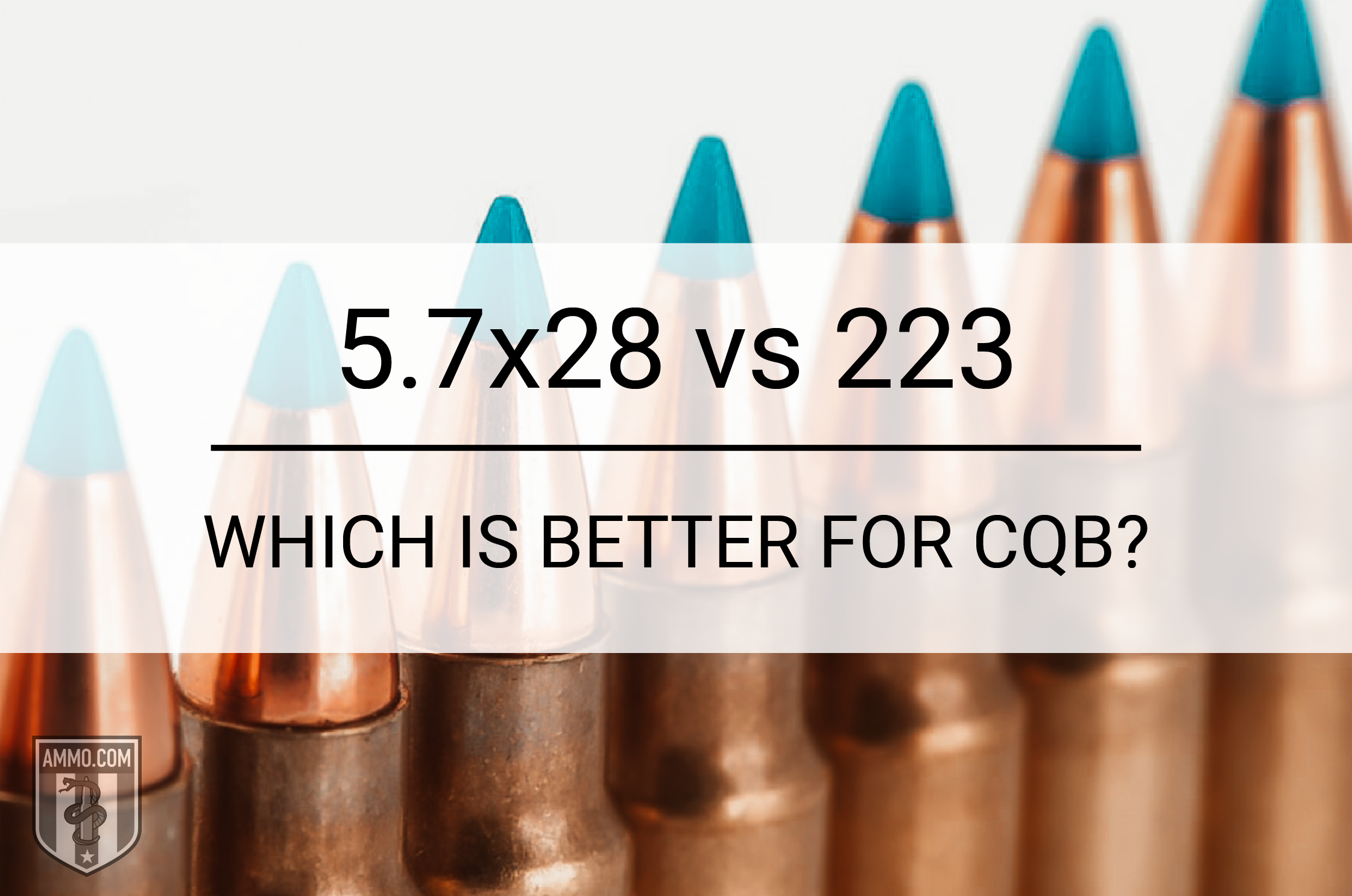 Like many a 2nd Amendment-loving teenagers of my generation, I was introduced to the FN 5.72x28 via the Showtime television series Stargate SG-1. Fans of the show will remember how the main characters, played by Richard Dean Anderson and Amanda Tapping, would travel across the galaxy battling alien forces armed with their full-auto FN P90s.
Like many a 2nd Amendment-loving teenagers of my generation, I was introduced to the FN 5.72x28 via the Showtime television series Stargate SG-1. Fans of the show will remember how the main characters, played by Richard Dean Anderson and Amanda Tapping, would travel across the galaxy battling alien forces armed with their full-auto FN P90s.
Although FN Herstal (FNH) did not initially develop the 5.7x28mm as an alien-slaying cartridge, it has become an integral part of multiple law enforcement and military organizations due to its impressive terminal ballistics, low recoil, and armor-piercing capability.
But how does the relatively new 5.7x28 round stack up to the most popular centerfire rifle cartridge in North America, the 223 Remington?
In this article we’ll take an objective look at how the 223 Rem compares to the 5.7x28 and give you some insights into both cartridges and how they apply to your self-defense needs.
What is the difference between 5.7 x 28 vs 223?
The difference between 5.7x28 and 223 is that the 223 is a rifle cartridge, whereas the 5.7x28 is classified as a handgun cartridge. The 5.7x28 was developed for use in a personal defense weapon (PDW) like a submachine gun or handgun for close-quarters battle (CQB), while the 223 Rem was developed for use in a carbine or rifle with a longer effective range.
A Note on Nomenclature
Please note that within this article we will refer to the 223 Remington (223 Rem) and the 5.56x45mm NATO round interchangeably. There are differences between the two, and you can read about them in this article: .223 vs 5.56.
In short, a 223 Rem can safely be fired from a rifle or handgun chambered in 5.56; however, the opposite is not true.
Cartridge Specs
When evaluating centerfire cartridges, it’s a good idea to analyze the cartridge specs to gain more knowledge of each.
One major similarity between 5.7x28 vs 223 is that they fire the same diameter bullet: 0.224”. However, this is where their similarities end.
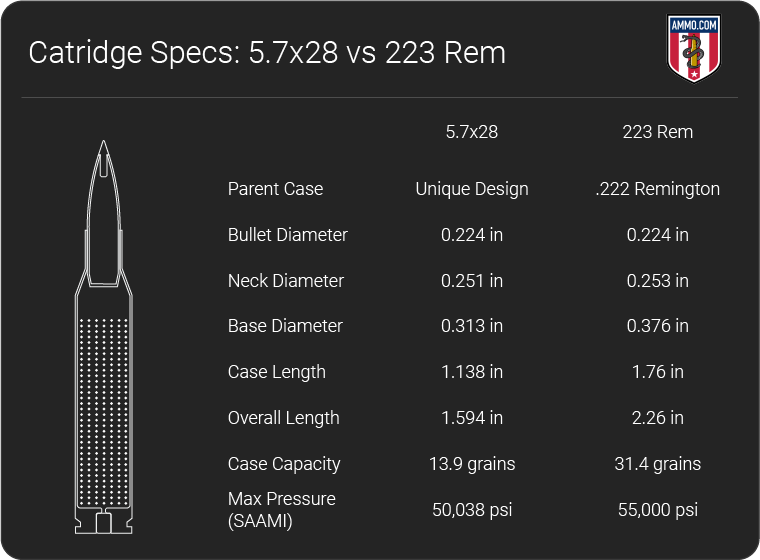
The simple truth is that the 223 Remington is just a bigger cartridge than the 5.7x28. The 223 Rem towers over the 5.7 in terms of case length, and has more than double the case capacity to show for it. The 223 Rem’s max chamber pressure is also 5,000 psi higher.
Due to its larger capacity, the 223 Rem can fire heavier bullets at higher velocities.
Recoil
When it comes to recoil, the 5.7x28 has considerably less than the 223.
Felt recoil will differ between rifles, shooters, barrel length, bullet weight, and powder charge. In fact, the FNH 5.7x28 is advertised as having approximately 30% less recoil than a 9mm Luger.
The 223 Remington is known for having low recoil for a rifle round. But as the 5.7x28 has half the powder charge and is firing lighter bullets, the 223 simply can’t keep up.
Assuming a 7lb rifle, the 223 will have an average free recoil of around 4 ft-lbs compared to 1.2 ft-lbs for NATO standard 5.7x28. To put this in perspective, a high-velocity 40 grain 22 LR cartridge delivers approximately 0.15 ft-lbs of recoil energy when fired in a 7lb rifle.
The low recoil of the 5.7x28 is one of the key selling points for using it in a submachine gun, PDW, or handgun. In these types of firearms, having low muzzle flip helps keep the shooter on target during rapid or full-auto strings of fire. This allows the shooter to get a lot of shots on target in a very short period of time.
One thing that many shooters discover is that it takes some training to get used to the recoil impulse of the 5.7x28, especially in a handgun.
Although the free recoil on the 5.7x28 is low, its bottle-neck cartridge and relatively large powder charge cause a rather large report in a handgun like the FN Five-seveN or Ruger-5.7”. The recoil impulse is also described as fast and a little snappy, but with very little energy imparted to the hands.
Loud report and fast recoil can be a bit surprising at first, but they can be easily controlled with proper training and grip.
Muzzle Velocity and Kinetic Energy
Although the 5.7x28 provides excellent muzzle velocity and kinetic energy for a pistol round, it simply cannot compare to the 223 Remington in this category.
The 223 Rem can fire a 55-grain bullet at 3,240 fps with 1,282 ft-lbs of muzzle energy.
When discussing the 5.7x28, it is important to note that there are two distinct types of 5.7x28 ammunition: military/law enforcement vs. sporting.
Due to the Gun Control Act of 1968, armor-piercing ammo capable of being fired in a handgun is illegal in the United States. The ATF has unconstitutionally expanded on this ban with some rifle rounds as well, primarily the 2014 banning of the importation of Russian 7N6 5.45x39mm ammo.
With this in mind, how is it possible for FN Herstal to sell the 5.7x28 in the United States, considering that the cartridge was specifically designed to penetrate Kevlar soft body armor?
FNH initially developed the 5.7x28 for NATO forces only. But after they saw the civilian applications for the round, they developed a sporting cartridge that worked around the ATF’s restriction on armor-piercing handgun ammo.
NATO standard 5.7x28, otherwise known as SS190, fires a 31-grain Hornady V-MAX bullet at 2,350 fps and 380 ft-lbs of muzzle energy. That’s more than sufficient to punch through NATO soft body armor.
The sale of this ammo to American civilians is prohibited by law, so FNH reduced the muzzle velocity of their sporting ammo to inhibit its armor-piercing ability. The ATF ruled that this ammo was acceptable, and is why it is legal to purchase 5.7x28 in the United States.
Federal American Eagle offers an FMJ sporting round that is popular with the 5.7x28 shooting community; it has a muzzle velocity of 1,655 fps and 243 ft-lbs of kinetic energy. A far cry from the full power NATO loads the Secret Service carries in their FN P90 submachine guns!
Trajectory
Trajectory is how we quantify a bullet’s flight path as it travels downrange, measured in inches of bullet drop.
Obviously, a flatter-shooting cartridge is preferred for long-range shooting, as a shooter will require fewer adjustments to their optics to compensate for bullet drop. Having a flatter trajectory also means that a cartridge will be more forgiving of ranging mistakes.
Comparing a rifle cartridge to a handgun round in terms of trajectory is not what many would consider a fair fight.
Rifle rounds are typically employed for long-range shooting, and rifles are often zeroed for 50 or 100 yards. Handgun rounds are generally used for close-quarters battles at short distances where trajectory is a non-issue.
As it stands, the 223 Remington has a much flatter trajectory at range compared to the 5.7x28.
For this comparison, we’ll consider the civilian-approved Federal American Eagle 40 grain FMJ 5.7x28 and 55 grain FMJ 223 Rem.
At 100 yards, the 5.7x28 round has experienced -3.8” bullet drop, which is incredibly flat-shooting for a handgun round. However, at 200 yards, the 223 round has experienced -2.7” bullet drop.
The high velocity of the 5.7x28 provides amazing trajectory for a handgun round, but it simply cannot compete with a centerfire rifle cartridge.
Ballistic Coefficient
Ballistic coefficient (BC) is a measure of how well a bullet resists wind drift and air resistance. Put another way, it’s a numeric representation of how aerodynamic a bullet is. A high BC is preferred as this means the bullet will overcome wind deflection more effectively, conserve a higher percentage of its velocity, and strike harder on impact.
Ballistic coefficient varies from bullet to bullet based on design, weight, and other factors that are beyond the scope of this article. That said, heavier bullets tend to exhibit higher BCs than their lighter counterparts.
As the 223 Remington can fire heavier bullets than the 5.7x28, the 223 will typically have a higher BC.
For example, Hornady V-MAX bullets which are commonly used for both cartridges. The 35 grain V-MAX for 5.7x28 has a BC of 0.109, while the 55 grain V-MAX for 223 holds a BC of 0.255.
Sectional Density
Sectional Density (SD) is the measure of how well a bullet penetrates a target. This is extremely important when hunting big and medium-sized game, as you need a bullet that can punch through thick hide, bone, and sinew.
Sectional density is calculated by comparing the bullet weight and bullet diameter. The higher the SD, the deeper the bullet will penetrate into the target. This is a simplified view of penetration, as there are other factors to consider, such as bullet expansion and velocity.
As the 223 can fire heavier bullets at a higher muzzle velocity than the 5.7x28, the 223 will generally penetrate deeper into its target than the 5.7x28.
Using the same V-MAX bullets as mentioned in the ballistic coefficient section, the 5.7x28 35-grain bullet will carry a SD of 0.100 while the 55-grain bullet for 223 has a SD of 0.157.
Hunting
When it comes to varmint hunting, it’s hard to beat a 223. Long regarded as an excellent pest control round, the 223 has been at the forefront of varmint and medium game hunting since its release in the 1960s.
The 223 is more powerful than any rimfire round on the market, eclipsing the 22 WMR and the centerfire cartridge, the 22 Hornet. Many consider it an excellent option for coyotes, woodchucks, and other medium-sized critters causing havoc on your property.
With the widespread popularity of the AR-15 carbine, hunters can enjoy quick follow-up shots of a semi-auto with a fire rate that simply cannot be matched by a bolt-action rifle.
The 5.7x28 has not caught on as a hunting round primarily due to a lack of hunting ammo options and firearms that utilize the cartridge. Although the 5.7x28 has been around for almost 30 years, it has been primarily relegated to the role of a self-defense cartridge. Truth is, there are many more effective and economical options for varmint hunting.
Could you go pop some woodchucks or raccoons with your FN Five-seveN pistol or Kel-Tec P50? Sure, it would work just fine for this within 100 yards. However, the 223 does the same thing for about half the cost, which is why it has remained the more popular hunting round.
Neither the 223 Remington nor 5.7x28 are good choices for whitetail. Regardless, most states/territories require a larger diameter bullet, like 0.243” or higher, for deer hunting.
Self-Defense/Home Defense
The 5.56 has been the frontline battle cartridge for the United States Military since the Vietnam War. Although the combat effectiveness of the round has been proven time and time again, the 5.7x28 is the better choice for self-defense and/or home defense.
The first reason I’d favor the 5.7x28 in a self-defense situation is magazine capacity. A standard Ruger-5.7 and FN Five-seveN pistol has a magazine capacity of 20 rounds, which is higher than almost every other self-defense cartridge on the market. By comparison, the Glock 17 magazine (9mm Luger) can hold 17 rounds, while the Glock 21 (45 ACP) can handle a mere 13 rounds.
For your home defense carbine, you could consider the CMMG Banshee AR handgun or SBR packing a 40-round magazine or Kel-Tec P50 that uses the 50-round P90 horizontal magazines. That’s a lot of bullets, and in any personal defense situation, you will always prefer more bullets to fewer.
The second reason the 5.7x28 is a better option for self-defense are its terminal ballistics and bullet design. Early bullet designs for the 223 Rem experienced fragmentation when they impacted soft tissue, causing additional damage. However, more recent battlefield reports question the fragmentation capabilities of current military loads. This could lead to overpenetration in a short-range engagement, and the last thing you want is your bullet to go through an attacker and strike an innocent bystander.
In contrast to the 223 designs, the 5.7x28 does not rely on fragmentation and instead was developed to destabilize and yaw when it impacts tissue. This tumbling causes additional damage to the target without the need for a conventional hollow point bullet, which is strictly prohibited for use in war by the Hague Convention of 1899. Although an American civilian is not constrained to wartime doctrine, the tumbling of the 5.7x28 bullets greatly reduces the chances of overpenetration. Furthermore, the lightweight bullets generally resist deflection, meaning you shouldn’t have to deal with the potential for ricochets.
Ballistic gelatin testing for some defense loads for 5.7x28 is quite impressive, especially for FN SS197SR. This sporting load was approved for civilian use. Topped with a 40-grain V-MAX bullet and carrying 2,034 fps and 256 ft-lbs at the muzzle, it is a formidable defense round.
The 223 Rem is an excellent self-defense option. However, the flat trajectory, low recoil and high magazine capacity of the 5.7x28 make it a superior choice. To tame the muzzle flip even more, a suppressor can be used indoors even on a SBR to make the 5.7x28 an incredibly soft-shooting, highly maneuverable package.
Ammo and Rifle Cost/Availability
When it comes to ammo cost and availability, the 223 Remington is the clear winner.
As the 5.56 NATO is a military cartridge currently in service, there is a plethora of surplus ammo available on the market that drives prices down. Furthermore, the widespread success of the AR-15 sporting rifle has catapulted the 223 to incredible heights of popularity.
Every major ammo manufacturer, including Hornady, Nosler, Sierra, Federal, PMC, Wolf and Remington, all have multiple factory loads for 223.
Buying in bulk is always smart. Make sure to check out our stock of 223 bulk ammo.
On average, cheap steel-cased 223 ammo can go as cheap as $0.40/round, while premium hunting ammo typically costs $1.20/round on average. In comparison, 5.7x28 ammo starts around $1.20/round for FMJ ammo and goes up from there.
The main problem with 5.7x28 is that only four major ammo manufacturers offer the cartridge currently, FN Herstal, Federal American Eagle, Hornady, and Speer. A general lack of ammo options has been the bane of the 5.7x28’s existence, thereby severely limiting its growth and acceptance as a mainstream cartridge.
And if the lack of ammunition wasn’t enough of a bottleneck, for many years, only two firearms fired the 5.7x28: the FN P90 and the FN Five-seveN handgun. More recently, new additions have been made to the 5.7x28 family of firearms: the CMMG Banshee line of AR-15 carbines and pistols, as well as the Ruger-5.7 and Kel-Tec P50 handguns.
Although the 5.7x28 is gaining somewhat in popularity, its market share does not even compare to the 223’s. Rifles and ammo for 223 are considerably more plentiful and less expensive than most all offerings for 5.7x28.
Reloading
If you enjoy reloading like me, then you’re going to love the 223 Rem. Handloading for the 223 is an awesome experience as brass is inexpensive and easy to find. Furthermore, components are relatively plentiful and can be found in most stores where reloading supplies are sold.
Although the 5.7x28 fires the same bullet diameter as the 223, the 5.7x28 typically fires lighter bullets than most shooters use in the 223 reloads. Furthermore, the 5.7x28 requires the use of pistol powders, whereas 223 uses slower-burning rifle powders. This means that you’ll need to buy different powders for both reloads.
The 223 is fairly well known as being a rather forgiving cartridge when it comes to reloading, meaning that minor variations in powder charge and bullet seating depth don’t have a major impact on the functionality of the round. This cannot be said for the 5.7x28.
Based on what I’ve learned from 5.7x28 reloaders, the round is incredibly temperamental, especially with bullet seating depth, shoulder length, and a polymer coating on the brass that comes from the factory to enhance extraction.
All of this is not to say that you can’t reload for 5.7x28, as many handloaders do it successfully every day. However, my recommendation is to be overly careful when handloading for 5.7x28 as it is a bit pickier than your average 223 reload.
Ballistics: 5.7x28 vs. 223
Our team here at Ammo.com has spent countless hours scouring the Internet to bring you extremely comprehensive ballistics tables for both calibers. Below are tables that compare bullet weight to muzzle velocity, kinetic energy, and trajectory for both 5.7x28 vs. 223 Rem.
223 Remington Ballistics
Note: This information comes from the manufacturer. Real-world results may – and probably will – vary. The actual ballistics obtained with your firearm can vary considerably from the advertised ballistics. Also, ballistics can vary from lot to lot with the same brand and type load.
| 223 Bullet WEIGHT | Muzzle VELOCITY (fps) | Muzzle ENERGY (ft. lbs.) | TRAJECTORY (in.) | |||||||||||
|---|---|---|---|---|---|---|---|---|---|---|---|---|---|---|
| Muzzle | 100 yds. | 200 yds. | 300 yds. | 400 yds. | Muzzle | 100 yds. | 200 yds. | 300 yds. | 400 yds. | 100 yds. | 200 yds. | 300 yds. | 400 yds. | |
| 35 Grain | 3750 | 3206 | 2725 | 2291 | 1899 | 1092 | 799 | 577 | 408 | 280 | 1 | 0 | -5.7 | -18.1 |
| 35 Grain | 4000 | 3353 | 2796 | 2302 | 1861 | 1243 | 874 | 607 | 412 | 269 | 0.8 | 0 | -5.3 | -17.3 |
| 40 Grain | 3650 | 3010 | 2450 | 1950 | 1530 | 1185 | 805 | 535 | 340 | 265 | 2 | 1 | -6 | -22 |
| 40 Grain | 3800 | 3305 | 2845 | 2424 | 2044 | 1282 | 970 | 719 | 522 | 371 | 0.84 | 0 | -5.34 | -16.6 |
| 45 Grain Green | 3550 | 2911 | 2355 | 1865 | 1451 | 1259 | 847 | 554 | 347 | 210 | 2.5 | 2.3 | -4.3 | -21.1 |
| 50 Grain | 3300 | 2874 | 2484 | 2130 | 1809 | 1209 | 917 | 685 | 504 | 363 | 1.37 | 0 | -7.05 | -21.8 |
| 52 Grain | 3330 | 2882 | 2477 | 2106 | 1770 | 1305 | 978 | 722 | 522 | 369 | 2 | 0.6 | -6.5 | -21.5 |
| 53 Grain | 3330 | 2882 | 2477 | 2106 | 1770 | 1305 | 978 | 722 | 522 | 369 | 2 | 0.6 | -6.5 | -21.5 |
| 55 Grain Green | 3240 | 2747 | 2304 | 1905 | 1554 | 1282 | 921 | 648 | 443 | 295 | 1.9 | 0 | -8.5 | -26.7 |
| 55 Grain | 3240 | 2748 | 2305 | 1906 | 1556 | 1282 | 922 | 649 | 444 | 296 | 2 | -0.2 | -9 | -27 |
| 60 Grain | 3100 | 2712 | 2355 | 2026 | 1726 | 1280 | 979 | 739 | 547 | 397 | 2 | 0.2 | -8 | -24.7 |
| 62 Grain | 3000 | 2700 | 2410 | 2150 | 1900 | 1240 | 1000 | 800 | 635 | 495 | 1.6 | 0 | -7.7 | -22.8 |
| 64 Grain | 2750 | 2368 | 2018 | 1701 | 1427 | 1074 | 796 | 578 | 411 | 289 | 2.4 | 0 | -11 | -34.1 |
| 64 Grain | 3020 | 2621 | 2256 | 1920 | 1619 | 1296 | 977 | 723 | 524 | 373 | 2 | -0.2 | -9.3 | -23 |
| 64 Grain | 3020 | 2621 | 2256 | 1920 | 1619 | 1296 | 977 | 723 | 524 | 373 | 2 | -0.2 | -9.3 | -23 |
| 69 Grain | 3000 | 2720 | 2460 | 2210 | 1980 | 1380 | 1135 | 925 | 750 | 600 | 2 | 0.8 | -5.8 | -17.5 |
| 75 Grain | 2790 | 2554 | 2330 | 2119 | 1926 | 1296 | 1086 | 904 | 747 | 617 | 2.37 | 0 | -8.75 | -25.1 |
| 75 Grain | 2790 | 2562 | 2345 | 2139 | 1943 | 1296 | 1093 | 916 | 762 | 629 | 1.5 | 0 | -8.2 | -24.1 |
| 75 Grain | 2790 | 2562 | 2345 | 2139 | 1943 | 1296 | 1093 | 916 | 762 | 629 | 1.5 | 0 | -8.2 | -24.1 |
| 75 Grain Super Match | 2930 | 2694 | 2470 | 2257 | 2055 | 1429 | 1209 | 1016 | 848 | 703 | 1.2 | 0 | -6.9 | -20.7 |
| 77 Grain | 2750 | 2584 | 2354 | 2169 | 1992 | 1293 | 1110 | 948 | 804 | 679 | 1.93 | 0 | -8.2 | -23.8 |
A Brief History of 5.7x28
Development of the 5.7x28 was initiated by a request from NATO to find a replacement for the 9x19 Parabellum round. Although the 9mm Luger had served NATO for many years, they wanted something with a longer effective range, enhanced terminal ballistics, and superior accuracy than the aging 9x19mm cartridge.
The ballisticians at FN Herstal quickly got to work and in 1990 the first iteration of the 5.7x28mm saw the light of day. The first cartridge was designated the SS90 and fired a 23-grain bullet plastic core bullet at 2,800 fps and had an effective range over 200 yards. When fired from the FN P90 submachine gun, the SS90 was capable of penetrating NATO CRISAT soft body armor or a NIJ Level III-A Kevlar vest.
In 1993 the SS90 cartridge was replaced by the SS190 AP cartridge that fired a 31-grain bullet at 2,350 fps. The SS190 had a shorter overall length that functioned more reliably in the FN Five-Seven pistol that was still being developed at the time and was released in 1998. Also developed at the time was the SB193 subsonic load for use with a suppressor.
From 2002-2003, NATO began evaluating the 5.7x28 against the German-made HK 4.6x30mm as a replacement for the 9x19mm Luger as their PDW cartridge.
Over a series of tests overseen by ballisticians of multiple NATO countries, the consensus was overwhelmingly in favor of the 5.7x28. Analysts cited lower temperature sensitivity of the 5.7x28, improved terminal ballistics over the 4.6x30, and increased barrel life for the 5.7x28. The evaluation committee also noted that the P90 and FN Five-Seven were already in production, while the HK MP7 was still only a design concept.
The stage was set for the 5.7x28 to become a standardized NATO cartridge, but then disaster struck at the hearts of Belgian chocolatiers and ammo manufacturers alike. The German Delegation could not take the hit to their ego, and they opposed the standardization of the 5.7x28, thereby killing any chances of it becoming the de facto NATO PDW cartridge.
This left both the 5.7x28 and the 4.6x30 in limbo. Both were accepted NATO cartridges and countries were left to elect either round based on their own preferences.
To date, the 5.7x28 is used by military and law enforcement agencies in over 40 nations.
Civilian versions of the 5.7x28 with reduced powder chargers were released in North America to avoid ATF restrictions on armor-piercing ammunition in 2004. Although the terminal ballistics of the 5.7x28 are impressive, the round has yet to reach widespread success like the 9mm Luger, 40 S&W, and 45 ACP. This is due, in part, to the relatively high price tag attached to 5.7x28 firearms in addition to many shooters having difficulty in sourcing a reliable source of ammo.
However, in recent years, newer firearms chambered in 5.7x28 have hit the market with relative success. The Ruger-5.7” and Kel-Tech P50 have revitalized the shooting world’s love for the 5.7x28 and the future is bright for this high velocity round.
To read more about the 5.7x28, check out the full history of the cartridge on our 5.7x28 history page.
A Brief History of 223 Remington
Development of the 223 Remington rifle round began in 1957 and the final design was submitted by Remington Arms to the Sporting Arms and Ammunition Manufacturers' Institute (SAAMI) in 1962.
The development of the 223 Remington cartridge was a joint operation organized by the U.S. Continental Army Command between Fairchild Industries, Remington Arms, and Eugene Stoner of Armalite, using the 222 Remington as a parent cartridge.
The 222 Remington case was elongated 0.06” and the neck was shortened. These changes allowed for the new 223 Remington ammunition to have a 20% larger powder charge than its progenitor.
Eugene Stoner was the primary inventor of the AR-10 rifle (chambered in 7.62x51 NATO), which he was invited to scale down to accommodate the new .223 Rem cartridge.
The resulting rifle that the military accepted was the M16, the civilian version being the AR-15. Since its adoption, the AR-15 carbine has become the most popular sporting rifle in US history.
With its lightweight and low recoil, the M16 is an ideal platform for full-auto fire, and the ammo is considerably lighter than its 308 Winchester counterpart. This allows soldiers to carry more ammo into battle for the same weight, meaning they can stay in the fight longer without impeding their mobility.
Since then, the M16 and the shorter barrel length M4 Carbine have become a ubiquitous symbol of American military prowess across the globe.
The original 223 Rem mil-spec ammo that the U.S. Military adopted was named M193, which fired a 55 gr full metal jacket (FMJ) bullet at a muzzle velocity of 3240 FPS with a muzzle energy of 1282 foot-pounds.
The new 223 Remington cartridge had sufficient long range capability out to 500 yards while maintaining accuracy and offers bullet weights between 35 and 77 grains.
The 223 Rem was released to the civilian market one year before adoption by the U.S. Army, and varmint hunters enjoyed the new cartridge’s low recoil, extreme accuracy, and lower pressure.
It was not long before all the major firearm manufacturers offered semi-auto and bolt action rifle in the new 223 Remington cartridge.
To read more about the 223 Remington, check out the full history of the cartridge on our 223 Remington history page.
If you’d like to learn more about how the 223 Rem compares to other calibers, check out these articles below:
Final Shots: 5.7x28 vs. 223
When comparing the 5.7x28 vs 223, it’s important to remember that the cartridges fill completely different tactical roles.
The 5.7x28 was developed for use in handguns and submachine guns. It has very low recoil and, when used in conjunction with a suppressor, is incredibly flat shooting and easy to handle. In contrast, the 223 Remington is a frontline battle rifle cartridge that has more than double the case capacity and combat-effective range compared to the 5.7x28.
Although the terminal ballistics of the 5.7x28 are impressive for a round of its size, its widespread acceptance as a mainstream cartridge has been hamstrung due to the lack of easily accessible ammo and firearms. Firearms manufacturers seem to be warming up to the 5.7x28, such as Kel-Tec and Ruger. But until more ammo manufactures start offering loads in 5.7x28, it will remain a task for proponents of the cartridge to locate ammunition.
On the other hand, 223 ammo can be found at almost any sporting goods location and is relatively inexpensive compared to the 5.7x28.
The choice between the two cartridges boils down to what you are wanting to do with your carbine or handgun.
If you’re looking for a rifle that can reach out to longer ranges over 500 yards with minimal recoil, then the 223 is the better option. However, if you’re looking for a lightweight and maneuverable personal defense weapon that packs a punch with incredible magazine capacity, you should seriously look at the 5.7x28.
Regardless of which you choose, make sure that you get all of your ammo here at Ammo.com and flex your 2A Rights whenever you can.
Ammo Comparisons
- .308 vs 5.56
- 6.5 Creedmoor vs .308
- .300 Blackout vs .308
- .300 Win Mag vs .308
- .243 vs .308
- .308 vs .30-06
- 7mm-08 vs .308
- .270 vs .308
- 7.62x39 vs .308
- .223 vs .308
- .338 Lapua vs .308
- .380 ACP vs 9mm
- .223 vs 5.56
- .300 Blackout vs 5.56
- 9mm vs 45 ACP
- 9mm vs 40 S&W
- .357 SIG vs 9mm
- 10mm vs 9mm
- 9mm vs 9mm Luger
- .243 vs .270
- .300 Win Mag vs .30-06
- .270 vs .30-06
- .40 vs .45
- 38 Special vs 357
- 9mm vs 40 vs 45
- 5.56 vs 7.62x39
- 338 Lapua vs .30-06
- .30-30 vs .30-06
- 300 PRC vs 338 Lapua
- .30-06 vs 7mm
- 300 Win Mag vs 338 Lapua
- 300 PRC vs 300 Win Mag
- 300 WSM vs 300 Win Mag
- 338 Win Mag vs 338 Lapua
- 12 Gauge vs 20 Gauge
- 10mm vs 357 Mag
- .30-30 vs 7.62x39
- 224 Valkyrie vs 22-250
- 17 HMR vs 22 Mag
- 7.62x39 vs .300 Blackout
- 45 ACP vs 45 Auto
- 45-70 vs 30-30
- 300 Blackout vs 223
- 357 Magnum vs 9mm
- 350 Legend vs 300 Blackout
- 224 Valkyrie vs 223
- 45 ACP vs 38 Super
- 6.5 Grendel vs .308
- 17 HMR vs 22 LR
- 10 Gauge vs 12 Gauge
- 22-250 vs 223
- 45 Colt vs 45 ACP
- 350 Legend vs 30-30
- 5.7x28 vs 223
- 5.7 vs 9mm
- 5.56 vs 5.7
- 22 vs 9mm
- Buckshot vs Birdshot
- 450 Bushmaster vs 308
- 450 Bushmaster vs 223
- Buckshot vs Slug
- 6.5 Grendel vs 5.56 vs 223
- 6mm ARC vs 6.5 Grendel
- 44 vs 45
- 458 SOCOM vs 5.56
- 357 vs 44
- 32 ACP vs 380
- 300 Win Mag vs 338 Win Mag vs 338 Lapua Mag
- 450 Bushmaster vs 458 SOCOM vs 50 Beowulf
- 6mm Creedmoor vs 6.5 Creedmoor
- TMJ vs FMJ
- 44 Special Vs 44 Magnum
- 45 90 vs 45 70
- 6.8 Western vs 6.8 SPC
- 50 Beowulf vs 50 BMG
- 26 Nosler vs 6.5 PRC
- 28 Gauge vs 410
- 6.8 SPC vs 5.56
- 6.8 SPC vs 6.5 Grendel
- 6.8 Western vs 7mm Rem Mag vs .28 Nosler
- 6.8 Western vs 6.5 Creedmoor
- 22 Hornet vs 223
- 6.8 Western vs 6.5 PRC
- .410 vs 12 Gauge
- .410 vs 20 Gauge
- 22 LR vs 22 Mag
- 6mm ARC vs 243
- 7mm-08 vs 270
- 243 vs 6.5 Creedmoor
- Nickel vs Brass Casing
- 204 Ruger vs 223
- 50 Beowulf vs 5.56
- 260 Remington vs 6.5 Creedmoor
- 6mm Remington vs 243
- 28 Nosler vs 300 PRC
- 50 Beowulf vs 50 AE
- 22 Nosler vs 22-250
- 450 Marlin vs 45-70
- 300 Win Mag vs 300 Norma
- 458 SOCOM vs 300 Blackout
- 38-55 vs 45-70
- 22 Hornet vs 22 LR
- 300 Norma vs 338 Lapua
- 338 Lapua vs 50 BMG
- 28 Nosler vs 300 Win Mag
- 28 Nosler vs 6.5 Creedmoor
- 204 vs 22-250
- 458 SOCOM vs 45 70
- 44 40 vs 45 70
- 6.8 SPC vs 6.5 Creedmoor
- 450 Bushmaster vs 30-06
- 7mm Rem Mag vs 300 Win Mag
- 30 Carbine vs 223
- 25-06 vs 30-06
- 26 Nosler vs 28 Nosler
- 16ga vs 12ga
- 30 06 vs 7.62 x54R
- 9mm Makarov vs 9mm Luger
- 350 Legend vs 223
- 30 Carbine vs 5.56
- 6.5x55 vs 6.5 Creedmoor
- 6.5 Creedmoor vs 270 vs 25-06
- M193 vs M855
- 450 Bushmaster vs 458 SOCOM
- 6.5 Grendel vs 6.5 Creedmoor
- 350 Legend vs 5.56
- .277 Fury vs 6.8 SPC
- 277 Fury vs 300 Win Mag
- 10mm vs .45 ACP
- 277 Fury vs 223
- 6.8 SPC vs 300 Blackout
- 6.5 PRC vs 6.5 Creedmoor
- 277 Fury vs 308
- 277 Fury vs 6.5 Creedmoor
- 350 Legend vs 450 Bushmaster
- 277 Fury Vs 5.56 NATO
- 10mm vs 40S&W
- 32 ACP vs 9mm
- 32 Special vs 9mm
- 8.6 Blackout vs 300 Blackout
- 30 Super Carry vs. 9mm
- 5.56 vs 9mm
- .50 Action Express vs 9mm
- 7.62x25 vs. 9mm
- 10mm vs 44 Magnum
- 300 Blackout vs 300 Win Mag
- 6.5 Grendel vs 300 Blackout
- 460 Rowland vs 10mm
- 300 RUM vs 300 PRC
- 300 Norma vs 300 PRC
- 45 GAP vs 45 ACP
- 7mm PRC vs 300 Win Mag
- 300 PRC vs 6.5 Creedmoor
- 300 PRC vs 308
- 357 SIG vs 357 Mag
- 7.62x39 vs 7.62x51
- 243 Win vs 223 Rem
- 30 Nosler vs 300 PRC
- 6.5 Creedmoor vs. 30-06 Springfield
- 450 S&W vs. 44 Magnum
- 6.5 Creedmoor vs. 300 Win Mag
- 454 Cassull vs. 45-70 Govt
- 454 Cassull vs. 44 Mag
- 7.62x54r vs. 308 Winchester
- 22 ARC vs. 223 Rem
- Subsonic vs. Supersonic Ammo
